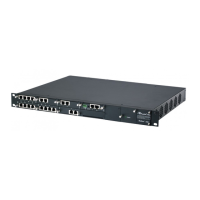SIP User's Manual 602 Document #: LTRT-83310
Mediant 600 & Mediant 1000
Parameter Description
last entry, and concatenates a new destination to it (if an additional
request is sent). The order of the reasons is as follows:
a. Q.850 Reason
b. SIP Reason
c. SIP Response code
Upon receiving the final response (success or failure), the device
searches for a Redirect reason in the History-Info (i.e., 3xx/4xx SIP
reason). If found, it is passed to ISDN according to the following
table:
302 - Moved Temporarily Call Forward Universal (CFU)
408 - Request Timeout Call Forward No Answer (CFNA)
480 - Temporarily Unavailable
487 - Request Terminated
486 - Busy Here Call Forward Busy (CFB)
600 - Busy Everywhere
If history reason is a Q.850 reason, it is translated to the SIP
reason (according to the SIP-ISDN tables) and then to ISDN
Redirect reason according to the table above.
User Agent Server (UAS) Behavior:
The History-Info header is sent only in the final response.
Upon receiving a request with History-Info, the UAS checks the
policy in the request. If a 'session', 'header', or 'history' policy tag is
found, the (final) response is sent without History-Info; otherwise, it
is copied from the request.
Web: Use Tgrp Information
EMS: Use SIP Tgrp
[UseSIPTgrp]
Determines whether the SIP 'tgrp' parameter is used. This SIP
parameter specifies the Trunk Group to which the call belongs
(according to RFC 4904). For example, the SIP message below
indicates that the call belongs to Trunk Group ID 1:
INVITE sip::+16305550100;tgrp=1;trunk-
context=example.com@10.1.0.3;user=phone SIP/2.0
[0] Disable (default) = The tgrp' parameter isn't used.
[1] Send Only = The Trunk Group number is added to the 'tgrp'
parameter value in the Contact header of outgoing SIP messages.
If a Trunk Group number is not associated with the call, the 'tgrp'
parameter isn't included. If a 'tgrp' value is specified in incoming
messages, it is ignored.
[2] Send and Receive = The functionality of outgoing SIP
messages is identical to the functionality described in option 1. In
addition, for incoming SIP INVITEs, if the Request-URI includes a
'tgrp' parameter, the device routes the call according to that value
(if possible). The Contact header in the outgoing SIP INVITE (Tel-
to-IP call) contains “tgrp=<source trunk group ID>;trunk-
context=<gateway IP address>”. The <source trunk group ID> is
the Trunk Group ID where incoming calls from Tel is received. For
IP-Tel calls, the SIP 200 OK device's response contains
“tgrp=<destination trunk group ID>;trunk-context=<gateway IP
address>”. The <destination trunk group ID> is the Trunk Group ID
used for outgoing Tel calls. The <gateway IP address> in “trunk-
context” can be configured using the parameter
SIPGatewayName.

